|
Common names:
China |
Chinese Mandarin |
鳞峡齿弹涂鱼, 鱗峽齒彈塗魚 (lin xia chi tan tu yu - scaled-isthmus teethed mudskipper) |
Finland |
Finnish |
hopealiejuryömijä, sädeliejuryömijä |
Italy |
Italian |
saltafango ornato* |
* proposed name
|
|
|
Synonyms:
Etymology:
'Periophthalmodon' is a compound form from 'periophthalmus' and the Greek 'odous' (tooth), which refers to
the prominent teeth and strong similarity to the genus Periophthalmus
'septemradiatus' means 'with seven rays' in Latin, which refers to the number of spines in D1
|
Maximum recorded length:
86 mm SL (Murdy, 1989)
100 mm SL (Talwar & Jhingran, 1991)
Live colouration
(Takita et al., 1999; Khaironizam & Norma-Rashid, 2003; pers. obs.: Peninsular Malaysia):
background colour of body grey to brownish, dorsally paler, white on venter and throat; margins of opercles dark; a brown
stripe runs dorsally and posteriorly from each orbit to the end of D1 or D2, becoming a row of irregular dark blotches, up to caudal peduncle; these two series of dark dorsolateral blotches may form a pattern of 8-10 saddle-like bars (see Fig. E); numerous small dark brown, pale red and pale blue speckles on snout, opercles and flanks; in young white speckles (instead of dark ones) are present (Takita et al., 1999); scales on opercles may present darker margins; D1 blackish to dark blue with reddish margin in males; D2 dusky with series of dark speckles on rays and a red margin; pectoral fins greyish with red speckles on rays; caudal fin dusky with series of dark speckles on rays; anal and pelvic fins dusky to dark grey distally; pelvic fins dorsally and proximally bluish in males; live colouration is quite variable through its distribution and probably also presents conspicuous ontogenetic changes (see photographs)
Colouration on preservation (Murdy, 1989;
Khaironizam & Norma-Rashid, 2003; pers. obs.: Insular and Peninsular Malaysia, Myanmar, Bangladesh):
background colour of body brownish laterally, white to tan on venter and dorsum; dark speckles on flanks; in some specimens a wide and irregular brown
stripe coursing posteriorly from orbit, passing dorsal to pectoral base and midlateral area, up to caudal peduncle; in
some specimens the posterior part of this stripe is interrupted, resulting in a series of irregular blotches; in some
specimens, cheek and opercle with brown spots and scales with darker edges; in females, all fins pale brown; in males, D1 and D2
blackish to brown with pale margins, D2 paler with series of dark spots on rays; caudal fin brown, medially darker: series of dark speckles on rays often visible; anal, pelvic, and pectoral fins dusky to pale brown; pelvic fins dorsally and proximally darker
Diagnosis (Murdy,
1989):
D1 IV-XV; pectoral fin rays 12-15; length of D1 base 3.2-17.9%SL; no pelvic basal membrane (separate),
pelvic frenum lacking; dorsal fins connected by membrane in adult male specimens; isthmus scaled; snout
lacking scales; species-specific sexual dimorphism: D1 greatly reduced in females; in adult males, D1 first
spine elongated; in both sexes, all D1 spines extend beyond membrane (see also Periophthalmus weberi).
The genus is characterised by the presence of two rows of teeth on the upper jaw;
in this species the second row of teeth in the upper jaw
contains few and smaller teeth, often half buried in the mucosa (pers. obs.)
Diet:
no published study is available
|
|
Reproduction:
no published study is available
|
|
|
|
Ecological notes (Khaironizam & Norma-Rashid, 2003,
Takita et al., 1999, pers. obs.: Peninsular Malaysia):
it is found on the mud banks covered by vegetation (mangroves, nypah palms, etc.) of almost freshwater waterways (up to 0 ppt), e.g. the upper reaches of estuaries and their small tributaries. It can be found sintopically with Periophthalmus gracilis and P. variabilis. It is one of the few oxudercine species that when it is chased, often escapes towards land and not plunging into water (pers. obs.)
Morphological and eco-ethologal traits closely resemble those ones of the Australian and Papuasian P. weberi .
It is the only known fish which was demonstrated to communicate acoustically while out of water (Polgar et al., 2011).
middle: mud banks of the Selangor river, peninsular Malaysia, at about 15 km from the rivermouth
|
|
|
|
Distribution (Murdy, 1989; Khaironizam & Norma-Rashid, 2003):
from northern India, Myanmar, Thailand, peninsular and insular Malaysia;
type locality: near Ganges delta, India
|
|
|
Remarks:
Hamilton (1822) described two species in the same publication: Gobius septemradiatus and G. tredecemradiatus, both from the Gange's delta. All the type material is lost and original descriptions are not diagnostic (Murdy, 1989). For these reasons, Murdy (1989) decided to synonymise these two species, with the former one as senior synonym, and designated a neotype (SU 40076) collected in Uttarbhag (Kolkata, West Bengal, India), at a shorter distance from the locality where Hamilton collected the two types.
In Peninsular Malaysia, this species had only been recorded in Kampung Kuantan, a small village nearby the banks of the river Selangor (Khaironizam & Norma-Rashid, 2003). This species is probably at risk of local extinction in this region, due to the almost total eradication of supratidal swamps (Polgar, 2008; Polgar & Sasekumar, 2010)
|
Photographs of Periophthalmodon septemradiatus:
|
|
A: female freshly dead specimen; B-D: specimens in aquarium; note the variable pattern of colouration along flanks in B and C
(photos: G. Polgar, Kuala Selangor, Malaysia, 2006); E: a specimen in its habitat (photo T. Takita, Sumatra, Tebing Tinggi Is., 1997)*;
F-H: Vietnamese specimens in their habitat (photo: Akinori Kamiya "Yamaneko" © umisuzume)*; I: another specimen in aquarium (photo: A. Norman, in: Tropical Fish Hobbyist,
1998 © TFH); J: two fighting specimens in aquarium (photo: Akinori Kamiya "Yamaneko" ©
umisuzume)*; K: preserved specimens (photo © California Academy of Sciences, Department of Ichthyology)*; L:
a radiograph (photo ©
California Academy of Sciences, Department of Ichthyology)* - * with permission
|
Drawings of Periophthalmodon septemradiatus:
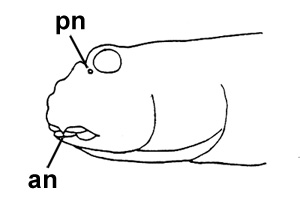
A
|
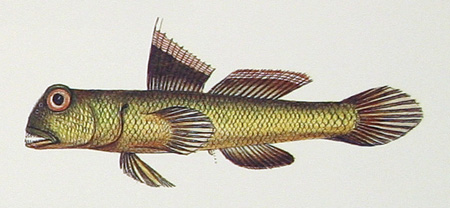
B
|
A: cephalic sensory and nasal pores of Periophthalmodon spp.: an = anterior nostril; pn = posterior nostril
(modified from Murdy, 1989)*; B: Periophthalmodon borneensis (Bleeker) (Bleeker, 1983)* - * with permission
|




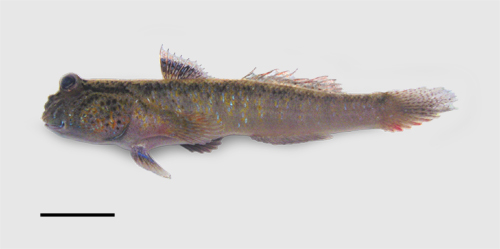
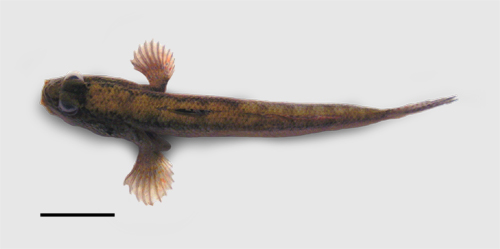
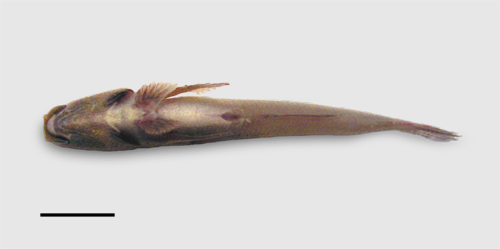
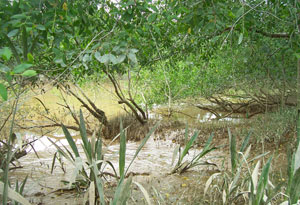
![]()